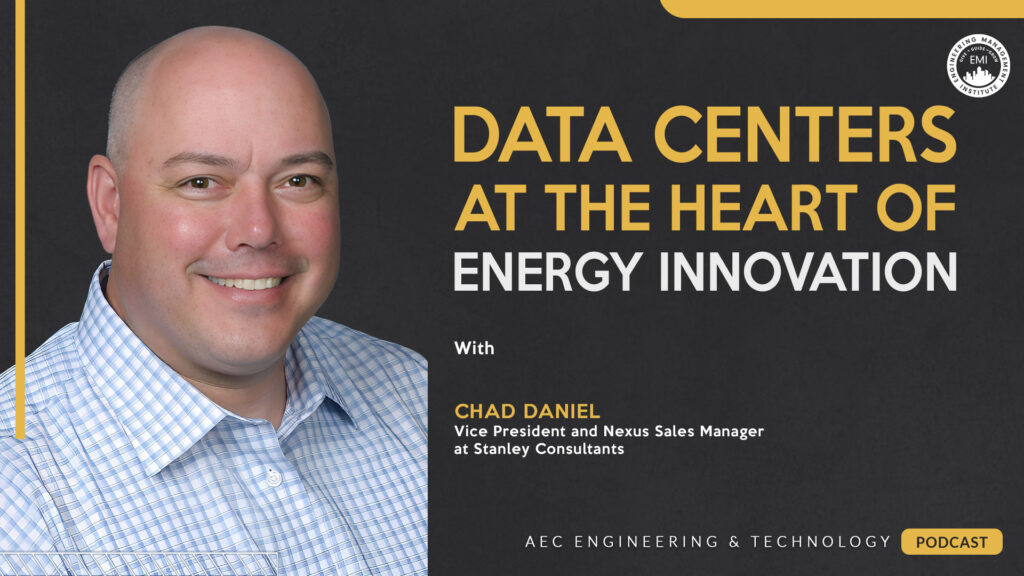In this episode, I talk with Chad Daniel, vice president and Nexus sales manager at Stanley Consultants, about the role of data centers in driving energy innovation. We explore key trends, challenges, and the transformative impact of AI and renewable energy on the future of power.
***The video version of this episode can be viewed here.***
Engineering Quotes:
Here Are Some of the Questions I Asked Chad:
- What changes are utilities and power producers experiencing, and how is this impacting the power engineering industry?
- How much additional power will need to be produced to meet the growing demand?
- Can you explain the timeline difference between building data centers and the infrastructure needed to power them?
- Aside from data centers, what other trends in power generation are driving demand and adding to the challenges?
- What shifts are happening in the business of building new data centers, especially in terms of market trends?
- Do you think renewable energy will eventually be able to fully meet the energy demands of data centers?
- From Stanley’s perspective, what professional services are essential for meeting the infrastructure needs of data centers?
- How can we balance the benefits of AI and big data with the environmental and other impacts of data centers?
- What final piece of advice would you give to AEC professionals and companies adapting to this rapidly changing space?
Here Are Some Key Points Discussed in This Episode About Data Centers at the Heart of Energy Innovation:
- Utilities and power producers experience a sharp increase in energy demand driven by AI data centers and electrification trends. This rapid growth pushes them to adapt quickly, managing challenges like long infrastructure timelines, supply chain constraints, and extending the life of existing energy sources such as coal and nuclear plants.
- Data centers are expected to grow from consuming 4% of U.S. electricity today to 9% by the 2030s, effectively doubling demand. This expansion requires significant energy production and infrastructure to meet both immediate and long-term needs.
- Data centers can typically be built in 12–36 months, but the infrastructure required to power them, like transmission lines, takes over seven years to complete. This timeline gap adds complexity to meeting rising demand.
- Electrification trends, including reshoring manufacturing to the U.S., increased adoption of electric vehicles, and the use of heat pumps in homes, drive energy demand. Combined with data centers, these trends significantly amplify the need for reliable and affordable energy.
- There is an increasing emphasis on securing utility connections and building onsite power generation to meet energy needs. Bridging solutions, such as low-carbon fuels, address immediate demands while facilitating a transition to renewable energy over time.
- Renewable energy sources, including solar, hydrogen, and modular nuclear reactors, are expected to meet the long-term energy needs of data centers. However, short-term reliability depends on bridging solutions like transitioning natural gas fleets to hydrogen while renewable infrastructure develops.
- Meeting data center demand requires comprehensive engineering services, such as land acquisition, permitting, and designing resilient infrastructure for power and water systems. These efforts ensure data centers operate with reliable energy and cooling systems.
- AI and big data deliver significant societal benefits, such as optimizing emergency services and supporting critical infrastructure, outweighing their environmental impacts. Achieving balance involves using renewable energy, improving efficiency, and maintaining robust infrastructure.
- AEC professionals focus on meaningful projects and prioritize strong relationships with clients and teams. Avoiding overcommitment and emphasizing quality and balance ensures sustainable success in a rapidly changing industry.
More Details in This Episode…
About Chad Daniel

About the Host: Nick Heim, P.E.

Nick’s interests lie at the intersection between the built world and technology, and he can be found looking for the ever-changing answer to the question, “How can we do this better?” Nick can be found on LinkedIn, producing content about use of technologies in his civil engineering career and small business.
Sources/References:
Stanley Consultants
ERCOT
Connect with Chad Daniel, LinkedIn
We would love to hear any questions you might have or stories you can share on how data centers are at the heart of energy innovation.
Please leave your comments, feedback, or questions in the section below.








